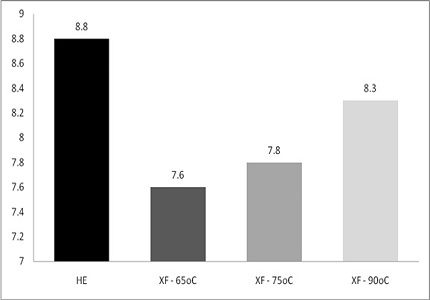Substitutes for xylene in histopathology and the role of temperature
Abstract
Background: Deparaffinization of wax sections in histopathology requires Xylene which is a harmful and toxic compound. It has been successfully replaced by many common household products such as dishwashing liquid, soaps and mineral oils. However, all these substitutes require higher temperatures of upto 90oC for effective deparaffinization.
Aim: To evaluate the temperature dependent efficacy of dishwashing liquid in deparaffinization of histopathological sections as a substitute to the routine toxic Xylene.
Method: 100 tissue sections deparaffinised by conventional Xylene and stained by Hematoxylin and Eosin method were objectively scored against 300 matched sections deparaffinised using dilute dishwashing liquid method at 65oC/75oC/90oC (100 each) by a single blinded pathologist.
Results: Based on Wilcoxon signed ranks test, at 90oC the Xylene free method stood on par with the conventional method (p=0.422, p>0.05) proving Xylene free sections were as good or better than the matching conventional sections in 76% of the comparisons. Xylene free sections at 65oC and 75oC were found to be inferior to the conventional method in 80% and 69% of the comparisons respectively and also statistically significant from the conventional method (p=0.002 and 0.019 respectively).
Conclusion: The new Xylene free method using dishwashing liquid is highly temperature sensitive and effective only at higher temperatures.
Downloads
References
2. Lars Falkeholm CAG, Anders Magnusson and Eva Möller . Xylene-Free Method for Histological Preparation: A Multicentre Evaluation. Lab. Invest.2001. 81(9):1213–21. [PubMed]
3. Pandey P, Dixit A, Tanwar A, Sharma A, Mittal S. A comparative study to evaluate liquid dish washing soap as an alternative to xylene and alcohol in deparaffinization and hematoxylin and eosin staining. J Lab Physicians 2014;6(2):84-90. doi: 10.4103/0974-2727.141504. [PubMed]
4. Ankle MR, Joshi PS. A study to evaluate the efficacy of xylene-free hematoxylin and eosin staining procedure as compared to the conventional hematoxylin and eosin staining: An experimental study. J Oral Maxillofac Pathol 2011;15(2):161-7. doi: 10.4103/0973-029X.84482.
5. Available from: The essential chemical industry online-materials and methods-surfactants:http://www.essentialchemicalindustry.org/materials-and-applications/surfactants.html (Accessed february 2016).
6. Available from: Pesky Pests and Household Hazards:http://www.epa.gov/sites/production/files/2014-06/documents/lesson2_handout.pdf (Accessed february 2016).
7. Ramulu S, Koneru A, Ravikumar S, Sharma P, Ramesh D, Patil R. Liquid dish washing soap: An excellent substitute for xylene and alcohol in hematoxylin and eosin staining procedure. J Orofac Sci 2012;4(1):37-42. doi: 10.4103/0975-8844.99890.
8. Indu S, Ramesh V, Indu PC, Prashad KV, Premalatha B, Ramadoss K. Comparative efficacy of cedarwood oil and xylene in hematoxylin and eosin staining procedures: An experimental study. J Nat Sc Biol Med 2014;5(2):284-7. doi: 10.4103/0976-9668.136167. [PubMed]
9. B R Premalatha SP, Roopa S Rao, M Indu (2013) Mineral oil--a biofriendly substitute for xylene in deparaffinization: a novel method. J. Contemp. Dent. Pract. 14(2):281-6. [PubMed]
10. Ananthaneni A, Namala S, Guduru VS, et al. Efficacy of 1.5% Dish Washing Solution and 95% Lemon Water in Substituting Perilous Xylene as a Deparaffinizing Agent for Routine H and E Staining Procedure: A Short Study. Scientifica. 2014;2014:707310. doi:10.1155/2014/707310.
11. Sangeetha R UK, Vidyadevi C, Vijay KJ, Mithilesh M, Premlatha BR (2014) Reagent-free H&E staining. J. Oral. Maxillofac. Pathol. 18(Suppl 2):S28–S35.
12. Kayser K, Bubenzer J .Microwave-assisted staining procedures in routine histopathology. Histochem. J. 1990 : 22(6-7):365-70.
13. Temel SG, Noyan S, Cavusoglu I, Kahveci Z . A simple and rapid microwave-assisted hematoxylin and eosin staining method using 1,1,1 trichloroethane as a dewaxing and a clearing agent. Biotech. Histochem. 2005 : 80(3-4):123-32. doi:10.1080/10520290500303190.
14. Kunhua W, Chuming F, Tao L, et al. A Novel Non-Toxic Xylene Substitute (SBO) for Histology. African Journal of Traditional, Complementary, and Alternative Medicines. 2012;9(1):43-49.



 OAI - Open Archives Initiative
OAI - Open Archives Initiative


